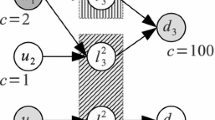Abstract
Most of the users of a BitTorrent community participate in multiple swarms, usually simultaneously as uploader and downloader. Thus the inter-swarm aspect of the bandwidth resource allocation has high relevance in the algorithm design of deployed BitTorrent clients. This inter-swarm connections among the users of a BitTorrent community can be represented by a flow network of special structure. Using this representation it has been demonstrated that de facto solutions to the resource allocation in BitTorrent communities are suboptimal. In this paper we investigate this conclusion in more details using graph measures and optimization techniques. We find that BitTorrent communities are sensitive for removal of highly contributing users, that the inter-swarm connectivity can lead to different performance results, and that torrent selection mechanisms can hardly improve the average download performance of users. Regarding the theoretical optimum of the discussed problem we show that it does not necessary comply with the BitTorrent protocol.




Similar content being viewed by others
Notes
Other seeding incentive mechanisms are existing and successfully used in communities, e.g. based on effort [6].
For the shake of simplicity we avoid the notion of time in the graph models.
Note that in these particular experiments we did not take the users’ bandwidths directly into account.
References
Wierzbicki A (2010) Trust and fairness in open. In: Distributed systems, vol 298. Springer, Berlin
Lan T, Kao D, Chiang M, Sabharwal A (2010) An axiomatic theory of fairness in network resource allocation. In: Proceedings of the IEEE INFOCOM, 2010, pp 1–9
Cohen B (2003) Incentives build robustness in BitTorrent. In: Workshop on economics of peer-to-peer systems, vol 6, pp 68–72
Chen X, Jiang Y, Chu X (2010) Measurements, analysis and modeling of private trackers. In: IEEE tenth international conference on peer-to-peer computing (P2P), pp 1–10
Liu Z, Dhungel P, Wu D, Zhang C, Ross K (2010) Understanding and improving ratio incentives in private communities. In: IEEE 30th international conference on distributed computing systems (ICDCS), pp 610–621
Rahman R, Meulpolder M, Hales D, Pouwelse J, Epema D, Sips H (2010) Improving efficiency and fairness in p2p systems with effort-based incentives. In: IEEE international conference on communications (ICC), pp 1–5
Vinkó T, Santos F, Andrade N, Capotă M (2013) On swarm-level resource allocation in BitTorrent communities. Optim Lett 7:923–932
Capotă M, Andrade N, Vinkó T, Santos F, Pouwelse J, Epema D (2011) Inter-swarm resource allocation in BitTorrent communities. In: IEEE international conference on peer-to-peer computing (P2P), pp 300–309
Ford LR, Fulkerson DR (1956) Maximal flow through a network. Can J Math 8:399–404
Goldberg AV, Tarjan RE (1988) A new approach to the maximum-flow problem. J ACM 35(4):921–940
Andrade N, Santos-Neto E, Brasileiro F, Ripeanu M (2009) Resource demand and supply in BitTorrent content-sharing communities. Comput Netw 53(4):515–527
Roozenburg J (2006) Secure decentralized swarm discovery in Tribler. Master’s thesis, Delft University of Technology (2006)
Isdal T, Piatek M, Krishnamurthy A, Anderson T (2007) Leveraging bittorrent for end host measurements. In: Uhlig S, Papagiannaki K, Bonaventure O (eds) Passive and active network measurement, vol 4427., Lecture notes in computer scienceSpringer, Berlin, pp 32–41
Amaral LAN, Scala A, Barthelemy M, Stanley HE (2000) Classes of small-world networks. Proc Natl Acad Sci 97(21):11149–11152
Caldarelli G (2007) Scale-free networks: complex webs in nature and technology. Oxford University Press, Oxford
Onnela J-P, Saramäki J, Hyvönen J, Szabó G, Lazer D, Kaski K, Kertész J, Barabási A-L (2007) Structure and tie strengths in mobile communication networks. Proc Natl Acad Sci 104(18):7332–7336
Chu X, Chen X, Jia A, Pouwelse J, Epema D (2014) Dissecting darknets: measurement and performance analysis. ACM Trans Internet Technol 13:125
Kash IA, Lai JK, Zhang H, Zohar A (2012) Economics of BitTorrent communities. In: Proceedings of the 21st international conference on World Wide Web. ACM, New York, pp 221–230
Cuevas R, Kryczka M, Cuevas A, Kaune S, Guerrero C, Rejaie R (2010) Is content publishing in BitTorrent altruistic or profit-driven? In: Proceedings of the 6th international conference, Co-NEXT 10. ACM, New York, pp 1–12
Meng X, Tsang P-S, Lui K-S (2013) Analysis of distribution time of multiple files in a P2P network. Comput Netw 57(15):2900–2915
Liang C, Zhao M, Liu Y (2011) Optimal bandwidth sharing in multiswarm multiparty p2p video-conferencing systems. IEEE/ACM Trans Netw 19(6):1704–1716
Peterson RS, Sirer EG (2009) Antfarm: efficient content distribution with managed swarms. In: NSDI
Dunn RJ, Gribble SD, Levy HM (2007) The importance of history in a media delivery system. In: IPTPS
Zhong L, Wang X, Kihl M (2011) Topological model and analysis of the P2PBitTorrent protocol. In: 9th World Congress on Intelligent Control and Automation (WCICA), pp 753–758
Delaviz R, Zeilemaker N, Pouwelse JA, Epema DHJ (2013) A network science perspective of a distributed reputation mechanism. In: IFIP networking, pp 1–9
Hu C, Shan D, Cheng Y, Qin T (2013) Inter-swarm content distribution among private bittorrent networks. IEEE J Sel Areas Commun 31(9-Supplement):132–141
Acknowledgments
This work was partially supported by the European Union and the European Social Fund through project FuturICT.hu (Grant No.: TAMOP-4.2.2. C-11/1/KONV-2012-0013). T. Vinkó was supported by the Bolyai Scholarship of the Hungarian Academy of Sciences.
Author information
Authors and Affiliations
Corresponding author
Rights and permissions
About this article
Cite this article
Vinkó, T., Botyánszki, B. Empirical investigation of BitTorrent community graphs. Computing 98, 567–582 (2016). https://doi.org/10.1007/s00607-015-0470-9
Received:
Accepted:
Published:
Issue Date:
DOI: https://doi.org/10.1007/s00607-015-0470-9




